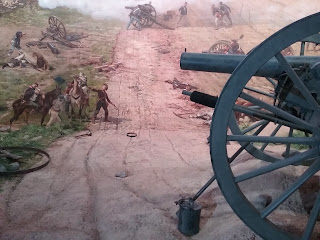Made it to Gettysburg today. Wandered around the downtown area for a while, including a stop by the
David Wills house, where a certain president stayed before delivering a certain well-known 'few brief remarks.'
 |
| Yep, Lincoln slept here. |
I also got to attend a special program at the battlefield interpretive center's
cyclorama, which was very fun. It was also appropriate, since I'm missing a conservation class to attend the symposium--there was a good hour of the conservation researcher discussing the construction, history, and restoration of the piece. Then she gave us a guided tour of it.
 |
Cyclorama at Gettysburg. The perspective was fascinating.
And the rope on this well sort of stole the show. |
It was a very up-close-and-personal tour. I actually got to duck under the painting and see it from the back, where all the seams are visible (unfortunately, the lighting levels were not good for my camera).
 |
But here's a view of the diorama, painting,
canopy, and roof, from below. |
 |
| See the road? |
 |
| This is me standing on that road. |
Fun fact: the battle detritus in the foreground "diorama" area is donated reenacting gear; they wanted it to needed to look used and weathered. Apparently, it moves around occasionally as new pieces are added or removed. Also, the plants are all fire-proof.































